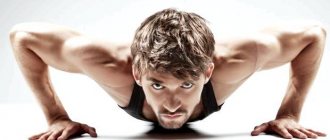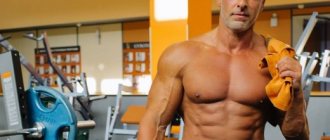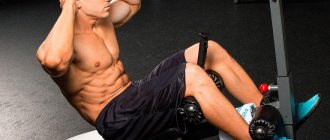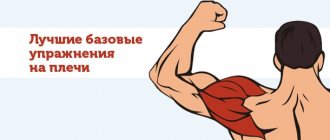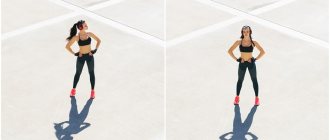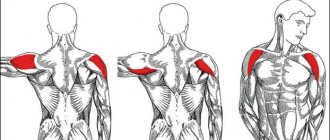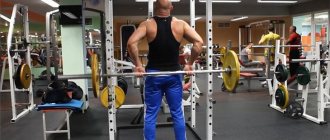© zamuruev — stock.adobe.com
Share:
What you need
- Barbell
- Dumbbells
- Exercise equipment
According to nature's intention, men should have harmonious V-shaped figures. Deltoids exercises will help you build broad shoulders. The article describes the most effective movements for working this muscle group. The load on the shoulders can be applied both with free weights and in the simulator. The best options will also help girls - a toned shoulder girdle on the fairer sex looks very attractive.
Anatomy of deltas
The deltoid muscle is not a single mass, but a group consisting of three bundles:
- anterior (clavicular part);
- middle (acromial part);
- posterior (spinous part).
© Alila Medical Media — stock.adobe.com
The frontal zone is involved in most exercises - it is the easiest to pump up. The side beams are responsible for the width of the shoulders - they need to be given special attention. The dorsal region is noticeable when viewed from the side - ignoring it, you will not get ideal spherical deltas.
No narrow grip when doing chin pulls
To do this, take a shoulder-width grip so that your elbows go straight to the sides and up. Ideally, when performing chin-up rows, the bar of the bar should literally slide along the body, without deflecting the bar too far forward.
If you take the barbell narrowly enough, for example 15-20 cm, then this forces the shoulders to bend forward strongly, which can be traumatic if the weight is large, while reducing the load on the middle delta being trained.
Make sure that you pull up with your elbows, do not bring the barbell up to your chin by about 10-15 cm. If after the exercise you feel that the deltoids are burning and engorged with blood, you are on the right track, if this is not the case, study the technique of moving with an empty fretboard You shouldn’t lift it up to the chin, otherwise the trapezius will be heavily involved in the work.
Recommendations for pumping deltas
There is no universal exercise for the deltoid muscles. Basic exercises involve several bundles, but individual zones are still a priority. Therefore, the training program should include a variety of movements for all three beams.
It is extremely rare that this muscle group develops evenly. As a rule, some bundles lag behind - most often these are the back and middle ones, since they are either forgotten about, or the exercises are performed incorrectly, or they do not do enough work, concentrating on the presses alone. Over time, you can focus on these particular beams, starting your shoulder day not with a bench press, but with swings on the rear and middle deltoids. But at the initial stage it is necessary to lean on the base, while not forgetting to pay attention to each beam. For beginners, two or three movements will be enough. Experienced athletes use 2-4 basic and 2-4 isolation exercises.
The recommended number of approaches per movement is 3-5, the number of repetitions is 8-15. It is recommended to train your shoulders once a week. Only with specialization among experienced athletes can deltas be divided into bundles over two to three days.
Pay special attention to warming up. Shoulders are a complex complex that can be easily damaged. It makes sense to include shoulder movements in the program after training the large muscle groups of the body. This will prepare the deltoids for stress and reduce the risk of injury.
If you experience pain in your joints and ligaments, stop training immediately. It is best in such cases to contact a specialist. By ignoring the problem, you risk missing out on pumping your case for several months.
You can't train your shoulders the day after training your chest.
On chest training days, the front deltoids receive a serious load, no matter if you perform it with a barbell or dumbbells, on a horizontal or inclined bench.
If you train your shoulders and triceps on the same day as your chest, this is acceptable, in another case, you can’t load your shoulders immediately after chest, they have not yet recovered and you won’t be able to handle good weight to pump up your shoulders, and besides, you can simply overtrain them , which means muscle growth will stop.
Therefore, if you have a shoulder day after your chest workout, leave at least 1-2 days of rest in between.
Delta exercises
Exercises for pumping deltas are divided into basic, which involve several joints at once, and isolating, which put stress on individual areas and one joint. Even at the very start, you should not give up isolation - such movements will have a positive effect on the overall result and will allow this muscle group to develop evenly.
Front beam exercises
All pressing movements on the shoulders should be classified as basic movements on the front beam. In many of them, the middle one works, but the emphasis is still on the front part.
Bench press standing and sitting from the chest
A basic movement that should be performed by both beginners and experienced athletes.
Technique for performing the exercise while standing:
- Place the barbell on the racks at shoulder level.
- Approach the bar and remove it from the racks by using an overhand grip slightly wider than shoulder-width apart (so that your forearms are strictly perpendicular to the floor) and placing the barbell on your upper chest.
- Take a step back, stand straight, feet slightly wider than shoulders and slightly bent at the knees - this is the starting position (IP). You must not bend your back during the entire approach! If you arch your back, reduce the weight.
- Smoothly, without jerking or using your legs, press the barbell up. At the same time, the elbows are slightly bent at the top point - this will help to avoid injuries to the elbow joint.
- Smoothly return the exercise to the IP, you don’t have to touch the barbell to your chest, but immediately begin the next repetition.
- Return the bar to the racks.
This is the most common option. But some athletes lift the barbell onto their chest not from the racks, but from the floor - with a jerk. To do this you need to have experience and appropriate technology. In addition, most in this version lose a certain percentage of the weight of the projectile.
The exercise can be performed while sitting, the technique will be similar, but in this case the load on the spine increases, but the deltoids work worse, as the pectoral muscles begin to engage.
© Makatserchyk — stock.adobe.com
A variation of the latter option is the Smith seated press. In this case, the trajectory of movement is set by the simulator, which reduces the number of stabilizer muscles activated. However, this variation can help you focus specifically on pumping the deltoids, excluding the pectoral muscles and triceps, since there is no need to pay much attention to balance and stabilization of the projectile. Try all the options and choose the one in which you better feel the load on your shoulders.
© Makatserchyk — stock.adobe.com
Bench press
This exercise can also be performed standing, sitting and in Smith. The movement is traumatic, and therefore requires certain preparation - both fundamental (good stretching, strong ligaments) and local (thorough warm-up).
© Makatserchyk — stock.adobe.com
Not recommended for beginners and amateurs in general - it is better to leave this option to professionals.
The technique of execution is also similar to the chest press, only the apparatus is located behind the head; accordingly, we take the barbell to the starting position as with classic squats. The weight here will be slightly less, since it is more difficult to control the projectile, and the movement is unphysiological for the shoulder joints. Be careful when lowering to avoid hitting your head. Also, do not lower the bar too low - it is enough to reach the bottom edge of the ears.
Dumbbell press standing and sitting
One of the best shoulder exercises. Most often, the movement is performed while sitting; in the case of dumbbells, this is the best option:
- IP - sitting on a bench with a vertical back (or located at an angle close to 90 degrees), arms with dumbbells are spread to the sides and bent at the elbows, the projectiles touch the deltas, palms “look” outward.
- As you exhale, press the dumbbells upward in a wide arc. There is no need to touch them at the top point. The elbows should be located under the hands, not moving forward. Do not arch your back to avoid increased stress on the intervertebral discs. At the top point, your elbows should remain slightly bent. Also try to hold the dumbbells so that your little fingers are higher than your other fingers.
- As you inhale, slowly return your hands to the IP position.
© Makatserchyk — stock.adobe.com
When doing a standing press, the technique is similar, but this option is rarely found in gyms.
© Fxquadro — stock.adobe.com
Another variation of this movement is the dumbbell (or kettlebell) press with one hand. When you have already reached serious weights, when pressing two heavy dumbbells, your back may somehow bend. To avoid this, you can reduce the load by performing alternate presses with one arm. This can be done both sitting and standing. Also, with this embodiment, the trapezius muscles are less involved in the work.
© blackday — stock.adobe.com
Arnold press
A variation of the dumbbell press, in which the position of the hands changes throughout the movement. In the starting position, the palms are facing the face, and in the final position, outward. The elbows are directed forward at the start. Otherwise, the Arnold press technique is similar to the previous exercise.
The main difference is that the Arnold press involves the middle bundles more than in the standard case.
Seated bench press
This movement is most similar to a dumbbell press, but here the trajectory is strictly limited by the design of the machine. The exercise is basic, but it should be performed after bench presses with barbells or dumbbells. Another option is to perform it as a warm-up with light weights before doing a heavy bench press.
© Makatserchyk — stock.adobe.com
Raises (swings) in front of you
This is the first isolated delt exercise in this review. It is done standing, with light weights. Can be performed with dumbbells (alternately and with two at once), a barbell, in a lower block or crossover (similarly, with two hands at once and one at a time).
Technique for performing with two dumbbells at the same time:
- IP - standing, feet shoulder-width apart, hands with dumbbells lowered down and located in front of the hips, straight grip.
- Without jerking or inertia, raise your arms in front of you, fixing them for a moment at shoulder level. There is no need to lift it higher - the load from the deltas goes to the trapezius.
- Slowly return your hands to the IP position.
© ruigsantos — stock.adobe.com
If performed with a barbell, one dumbbell or on a block, the technique is absolutely the same.
© Makatserchyk — stock.adobe.com
© Makatserchyk — stock.adobe.com
© Makatserchyk — stock.adobe.com
Alternating swings are also popular. In this case, it is easier to focus on one side. In addition, asynchronous lifts allow you to work with more serious weights. However, do not forget that you do not need to swing your body and throw dumbbells using inertia .
© Mihai Blanaru — stock.adobe.com
Alternating swings can also be performed in a crossover:
© Makatserchyk — stock.adobe.com
Exercises for middle beams
Here the emphasis is on the medial area.
Pull to the chin (broach)
Basic exercise, performed standing. The barbell is most often used, but options with dumbbells, as well as on the lower block/crossover and even in Smith, are acceptable.
© ruigsantos — stock.adobe.com
© Makatserchyk — stock.adobe.com
The traditional version involves a vertical stand and an emphasis on medium buns. To do this, the grip should be wide - wider than the shoulders. Narrow placement of the arms leads to greater load on the trapezius and anterior deltoids.
Technique:
- IP - standing, hands down, straight wide grip holding the bar in front of the hips.
- Using the efforts of the middle fascicles of the deltas, raise the bar to the level of the collarbones or lower, the level depends on the grip - the wider it is, the lower the bar will be. The elbows at the top point are slightly higher than the shoulders.
- Return your hands to the IP under control.
Like the overhead press, this exercise is dangerous . Therefore, the movements are smooth, and the weight of the projectile is relatively small. It is much more useful in this case to give preference to a multi-repetition style - 12-15 repetitions.
Lateral flyes (swings)
Isolated movement. The best way to do it is slowly and technically. Although more often in the gyms you can see it performed in a strength format - with cheating and throwing dumbbells upward with the help of swinging the body. Leave the last option to the professionals; to pump up your shoulders more effectively, this exercise should be done with light weight, without cheating, and in 12-15 repetitions.
Technique for performing swings while standing:
- IP – standing straight, no need to lean forward. Hands with dumbbells are lowered down and located at the sides, and not in front of the hips, with a neutral grip. You can bend them slightly at the elbows.
- Slowly spread your arms out to the sides. At the top point, at which the hands are at shoulder level, the palms are turned so that the little finger is on top - this maximizes the load on the middle bundles.
- Return your hands to the IP. There is no need to rest at the bottom and touch the thighs with the apparatus - immediately start a new repetition.
© Makatserchyk — stock.adobe.com
This exercise can be performed while sitting in a similar way. In this version, it is more difficult to cheat, which in this case is a plus.
© xalanx — stock.adobe.com
Swings can also be done in a crossover, using the lower handles (either with one hand alternately or with both at once). When doing this, the amplitude of movement increases (at the bottom point you can move the handle a little further), and the muscles are tense throughout the entire approach.
© Makatserchyk — stock.adobe.com
© Makatserchyk — stock.adobe.com
Also in many gyms you can find special machines for lateral swings. Here the technique is slightly different - as a rule, you need to bend your elbows and rest their outer sides on the pads of the simulator. In the future, the movement is the same - you need to spread your arms to the sides to shoulder level.
© Makatserchyk — stock.adobe.com
The last version of this exercise can be considered one-arm lateral raises while sitting sideways on a bench. You can use either a horizontal or an inclined bench. You need to lie on it sideways (if the bench is horizontal, place your elbow), take the dumbbell in your free hand with a neutral grip and lift it slightly above shoulder level (not to the vertical). There is no need to bend your arm. Try to feel exactly the middle fascicle of the deltoids.
© Makatserchyk — stock.adobe.com
Exercises for the back bundles
Bent-over flyes (swings)
The position of the body in this movement is almost parallel to the floor. Technique:
- IP - standing in a bent position, arms with dumbbells down, neutral or straight grip, knees slightly bent.
- Spread your arms to the sides, fixing them at the top point for a moment and trying to achieve maximum muscle contraction.
- Slowly return your hands to the IP position.
© Makatserchyk — stock.adobe.com
If you are uncomfortable doing the exercise while standing, you can similarly bend over from a sitting position or rest your forehead on the bench for balance.
There is another option for such exercises - lying face down on a bench. In this movement, the rear bundles are even more isolated, since assistance from the legs and body is eliminated. Here it is better to perform the movement with a straight grip and bent elbows so that the load does not go to the middle bun.
© Makatserchyk — stock.adobe.com
The exercise can also be performed in a crossover. Here the amplitude will be even a little greater, since when you take the right handle in your left hand and vice versa, at the lowest point you will move your arms further, and the deltoids will already be tense.
© Makatserchyk — stock.adobe.com
Reverse flyes on the Peck-Deck machine
This exercise builds the posterior deltoids and strengthens the rotator cuff muscles—a good option to prepare your shoulders for bench presses.
Technique:
- Adjust the seat height and handle position. Your arms should be raised to shoulder height and parallel to the floor.
- IP – chest pressed against the back of the machine, hands held in front of you with a neutral grip on the handle. At the start, it is advisable to spread your arms slightly so that the load rises a little.
- Extend your arms all the way (your elbows are behind your back), achieving maximum contraction of the bundles at the end point.
- Take a short pause and return your hands to the IP.
© fizkes — stock.adobe.com
Leads in crossover
This exercise uses the upper handles. There are two main implementation options:
- In the first, you grab the opposite handles with your hands, raise your arms to just above your shoulders and spread them to the sides. Perform the movement slowly and with light weight, trying not to squeeze your shoulder blades.
© Makatserchyk — stock.adobe.com
- The second embodiment involves a rope handle. Take it with both hands, take a couple of steps away from the crossover stand and pull the handle towards you, moving your elbows to the sides. An important point is that in most cases this exercise is performed with the arms located in a plane parallel to the floor. A slightly different technique will help to achieve a better effect, in which the arms in the extreme position are in a position as if you were showing a double biceps from behind. This is discussed in detail in the following video:
Recipes for healthy eating
Pasta with peppers and zucchini
- 3.3 g Protein
- 7.1 g Fat
- 19.9 g Carbohydrates
- 135.2 kcal
25-35 min.
- #dietary
- #zucchini
- #pasta
- #low calorie
- #dinner
- #vegetables
- #butter
- #cheese
- #dinner
Other recipes
Do not reduce the range of motion
Very often, gym goers with weights lift more weight so as not to fall in the eyes of other athletes, but at the same time the amplitude of movement is reduced, which reduces the effectiveness of the exercise.
For example, when performing a lateral raise with dumbbells, they are raised to shoulder level and not higher, but in vain, you need to bring your elbows to forehead level, and raise the lifts in front of you with dumbbells so that the angle of inclination is approximately 60-45 degrees, this is the only way to train deltoids will reach its maximum.
By lifting the weight above shoulder level, you are putting a new, unusual load on the deltoids; this stress will immediately affect the increase in muscle mass and strength, but you will have to sacrifice weight for the sake of ideal execution technique.
Training program
Let's look at how to pump up your deltoids at home and in the gym.
Home workout program
Designed for one separate workout per week and work with dumbbells:
| Exercise with dumbbells | Approaches | Repetitions |
| Seated dumbbell press | 4 | 10-12 |
| Swing in front of you | 3 | 12-15 |
| Dumbbell row to the chin | 4 | 12-15 |
| Lateral spreads | 3 | 12-15 |
| Bent-over lateral raises | 5 | 12-15 |
Train your rotator cuff
In most cases, no attention is paid to the shoulder cuff at all, and some have never heard of it and have no idea what it is and why it is needed.
The rotator cuff is a set of four muscle ligaments that, together with 3 delta bundles, provide all the work of the shoulder joint.
Even after they found out what it is, many reserve a place for training it at the end of the training, this is understandable, because in the first place, the mass of the shoulders, and train what is deep inside and no one except the surgeon will see why, meaning?!
This is where the biggest mistake is, as the deltoids grow and become stronger, you take more and more dumbbells, hang additional plates on the bar, but the rotator cuff remains weak, which ultimately leads to its injury. The result will be pain in the shoulder area, even when you put on a T-shirt.
Therefore, take dumbbells and rotate your shoulders in a circle for 10 repetitions forward and backward, or do the exercise as in the picture and so on at every shoulder workout, of course this work is not interesting and tedious, but it is very necessary for the health of the deltoids.
About the anatomical structure and functions
The shoulder joint is one of the most mobile in the human body. And he is helped to perform movements by 3 muscle bundles located on top - anterior, middle and posterior.
If you look at a fairly developed shoulder from the side, it resembles an inverted triangle or the ancient Greek letter “delta”. This is where the muscles of this part of the body got their second name.
The anterior bundle is located in the front. It is larger and stronger than other heads. The rear deltoid is located in the back. It is small in size and has the same strength abilities.
The middle beam is located between them. This is the second highest level of strength and potential for muscle hypertrophy of the humeral head.
She is responsible for the following movements:
- Moving the arm to the side
Here it works as isolated as possible from other muscle bundles.
Although, as soon as the technique of performing isolating exercises on the middle delta begins to break down, the front part is immediately involved in the movement.
- Overhead press
This part of the deltoid is involved in various variations of arm presses, sharing the load with the front by almost half.
- Raising the arm along the body
This function is used in standing barbell rows.
It is believed that if this exercise is performed with a wide grip and the barbell is pulled to chest level, the emphasis of the load will shift to the middle deltoid. But with a narrow grip and pulling the bar towards the chin, the front one works more.
Knowing the movements in which the muscle is involved, it becomes clearer how to pump up the middle delta. We'll talk about this further.
Don't arch your lower back while pressing
Having hung a decent weight on the barbell or taken fairly heavy dumbbells, in the last repetitions the back begins to deviate from the vertical, arching the lower back. This happens because the body begins to look for all possible ways to cope with the severity.
At this moment, you will squeeze out the weight, part of the load will transfer to the upper part of the pectorals, but the lower back will receive an unnatural deflection, which will lead to injury. Therefore, when performing a bench press, keep your lower back pressed tightly against the back of the gymnastic bench ; if it still arches, there is only one way out - to reduce the weight.
Train your shoulders correctly and then injuries will bypass you. Happy training!

